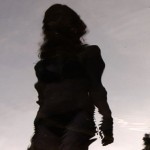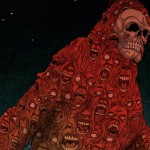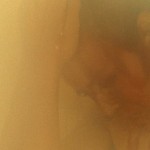TALKING IN SHORTHAND: ADAM WINGARD
“Does it make you feel nauseous, getting the pills out of the blister pack? To watch each one drop and know that you’re gonna take all these pills…you dedicated your night to this. You’ll know when it comes on.”
When Adam Wingard’s Pop Skull exploded onto the genre circuit in 2007, it signalled a major new talent. He already had one feature under his belt – the gore-drenched Home Sick , which had its world premiere at Fantasia that same year (the first festival to play his work anywhere in the world!) – but it was Pop Skull that established the heady, interior sensibility that would make Wingard unique on the scene.
Moving along ethereally like a drug-laden horror counterpart to David Gordon Green’s George Washington, Pop Skull depicts the lonely and disjointed life of Daniel (played by the film’s co-writer Lane Hughes), a young Alabama pill addict, as his efforts to cope with the trials of his day-to-day life collide with the increasing influence of murderous and displaced spirits that inhabit his home. As Daniel’s sense of reality deteriorates and phantasms run amok in his fuzzed-out mind, we too come to question what it is we are seeing and experiencing. The film moves in and out of Daniel’s head, beautifully contrasting moments of lucidity with frenzied chaos.
The low-light listlessness of Pop Skull would become a trademark for Wingard, and his characters going forward would routinely struggle for connection, while simultaneously shrinking from the violence that inevitably lay at the end of that pursuit. In Wingard’s films, intimacy seems hopeful – but is actually frightening and dangerous.
A Horrible Way to Die premiered at TIFF in fall of 2010, followed soon thereafter by Fantastic Fest and a slew of other high profile festival dates. But A Horrible Way to Die is only one of several features Wingard has been involved with over the past year…with a little help from his friends. He was kind enough to speak to us about his busy year , his own search for connectedness through his characters, and what his ongoing collaborations with founding mumblecore staple Joe Swanberg bring to the genre.
—————————–
You got an early start making films – supposedly you were only 19 when you made Home Sick? How did that come together?
I was fresh out of film school with my friend E.L. Katz and we decided that for our first feature we would start with what is considered artistically to be the lowest common denominator when it comes to filmmaking: the slasher film. Perhaps the noble thing would have been to try and make the best film ever first but I think we’ve always been realistic people and we knew we had a long road ahead of us so we might as well have fun doing our version of bad Italian filmmaking. It’s a pretty sloppy film but I’m still proud that we made it when we did under the circumstances.
I’ve directed two films, A HORRIBLE WAY TO DIE and WHAT FUN WE WERE HAVING. I co-directed another feature with Joe Swanberg called AUTOEROTIC and I shot three other films for Swanberg, ART HISTORY, BLACKMAIL BOYS and CAITLIN PLAYS HERSELF. I also shot the last ten minutes or so of this other feature he’s been shooting for the past two years called SILVER BULLETS. It’s been a long year.
A HORRIBLE WAY TO DIE will be released through Anchor Bay this September or so. Blackmail Boys, which is this weird gay erotic mumblecore thriller, will be released through TLA and is currently playing the Gay and Lesbian circuit of film festivals. Art History and Silver Bullets will premiere at Berlin, Caitlin just finished shooting, and AutoErotic and What Fun – which are both companion films – are being shopped to film festivals at the moment.
How are you funding your films?
It’s different every time but mostly through independent financers. Producers that throw us just enough cash to get the projects done. It’s been a pretty exhausting year because though working on all these films I’ve been pretty much broke, so I’m more or less floating around sleeping on people’s couches to get the job done. It’s not been comfortable, but this is the profession I chose and until I’m making larger budget productions, which looks to be soon, I’m not going to stop making these things just because I don’t have the money. I think in some ways this is the real test for me to make it to the next level. The first second I turn down a challenge just because I’m too lazy is when I have failed.
It’s been said that Pop Skull cost $6000. Is that true?? Because it looks amazing. Is there a benefit to working in that kind of a budget range – other than lower debt of course…?
It actually cost less than that. There really isn’t a great benefit to working for that low of budget because that’s really so low it’s a joke on you and everyone working with you. If there’s not enough money to pay yourself out of the budget it’s not really a real budget, it’s just money that pays for the bare minimum of requirements. I’m at the point now where it makes me sick to think about working at this level anymore. Yes, the good thing is nobody can tell you to do anything other than what you want to do, but on the flip side of that, if someone was telling you what to do for 3000 dollars you would be an idiot to listen to them. On A Horrible Way To Die we had a little bit of money and it never felt like I had to compromise creatively for anything. You should always know your producers and then no matter what level you’re working at, you can retain total control.
How did you end up collaborating with Joe Swanberg?
I met him at the local Alabama film festival here in Birmingham. He comes pretty much every year and I had chatted with him a few times. The last year before we started working together I ran into him in front of one of the theaters and sort of idly mentioned I’d love to shoot one of his movies for him. He told me he usually shoots his own movies and I thought I had offended him by saying that, so I quickly responded by clarifying that I meant when he is acting in his film. Fast forward a few months later I’m shooting all these segments for my date rape anthology which would later become What Fun We Were having and I asked him to come to Alabama to act in one of the segments, he agreed and we shot his whole scene out in one day. After that I think he became inspired by that sort of quick work ethic because he’s hired me to shoot pretty much everything for him since and we’ve done each movie in four to seven days a piece.
What kind of magic do you think happens by putting a ‘mumblecore’ ethos into genre film? (I know Joe hates that term, but for better or for worse it’s now a subgenre…)
To me mumblecore just represents the most modern version of realism. It’s not about completing whole thoughts or make well articulated conversational statements like you might see in an Aaron Sorkin film, mumblecore in contrast is about talking in shorthand the way human beings do, it’s about stripping down certain cinematic techniques and focusing on what is in front of you. For A HORRIBLE WAY TO DIE I shot the film from the point of view of a sort of post modern mumblecore. Its contrasty and uses atmospheric cinematic inventions but at the heart of it the movie is a realistic look at something fantastical. I don’t think mumblecore is a dirty word, it’s something to wear as a badge of honor.
It’s funny that Swanberg gets to jerk off on film..again! It’s his trademark!
Masturbation is probably the most under-used cinematic devices. It says so much about the character depending on the context you use it in.
Pop Skull was such a psychedelic film compared to the more recent ones, which I know was directly tied to the use of drugs in the film, but any interest in revisiting a style like this again?
I’ve been wanting to get back into directing more technical oddities like Pop Skull but it really depends on the material. Lately I’ve taken a more straightforward approach because I didn’t want it to get in the way of the material. Pop Skull was inspired by noise music, psychedelic drugs, and my own personal depression. I’d love to make another film that personal again but it does take a lot out of you. When I find the right drug story I’ll do it, maybe I just need to start doing acid or cough medicine again and I’ll know what to do!
Your characters are often so vulnerable and fragile, what draws you to characters like this?
I’ve noticed these days that I feel sort of detached as a human; I can’t remember the last time I cried or really let myself get excited about something. I love making movies, but I think I’ve sort of turned a lot of my emotions off. I think I gravitate to these people because reliving emotions through them makes me feel human, it helps me to remember that at the base of our existence is loneliness and desperation which returns in waves, and I can remember what that was like. Lately I’ve talked to a few teenagers that relate to Pop Skull, which is so rewarding for me. It was always meant to represent an adolescent view of sadness.
A Horrible Way to Die and What Fun We Were Having seem both very much about manipulation, all the different levels of manipulation people employ in their relationships with eachother. Do you think it’s possible to be in a relationship without manipulation? Do you think there are necessary kinds of manipulation?
I don’t know. That’s kind of a disturbing notion that I never put together. I think lately that manipulation is something I’ve been more focused on since I’ve found myself in a long term relationship for the first time in my life. My girlfriend used to be obsessed on infidelity and honesty and that sort of drove me crazy and ever since I’ve been battling with it. Everything we make comes from somewhere deep within us, what these films say about me I DO NOT KNOW or really want to know.
——————–
Fantasia has been honoured to have premiered Wingard’s Home Sick and several of his short films (in fact, we were the first festival anywhere in the world to have shown his work!) See more of his work at Fantasia 2011 – stay tuned for details!
——————-
– Interview by Kier-La Janisse

 April 1, 2011
April 1, 2011  No Comments
No Comments










